Just over two years ago, I penned a blog text describing a Passover Haggada that I had purchased online. It caught my attention due to the lists of names written on the inside front and back covers of individuals who attended the Passover Seders over the course of seven years that were held in two residences in Berlin, both of which were in close proximity to the Jewish Museum Berlin. Research revealed a substantial amount of information about various persons named therein and my text concluded with the hope that contact might be established with descendants of some of those found in the lists.
At the end of March of this year, I flew to Stockholm to visit Alexander Summerville, the great grandson of Paul Aron, in whose home in the Hedemannstraße 13/14 Passover Seders took place in five of the years for which lists exist in the Haggada. I had received Alexander’s name through two further great grandchildren of Paul Aron, whom I had contacted earlier and whom I also had the pleasure of meeting during my brief stay in the Swedish capital.
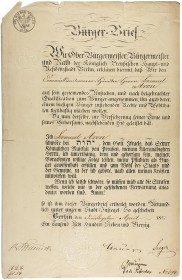
Certificate of citizenship for Samuel Aron, Berlin 1847; Jewish Museum Berlin, gift of Alexander Summerville, photo: Steffen Engelmann
Although I had corresponded and spoken with Alexander in advance of my trip, I did not anticipate the richness and scope of materials that he had pertaining to his family history: paintings of his ancestors, linens, clothing and accessories, books, pamphlets, and a large number of documents and many photographs. Of the eleven individuals whose names appear most often in the lists, documents and/or photographs pertaining to nine were to be found within the collection: Emanuel Stern, the owner of a large cloth factory in Aachen and his wife Johanna née Leven, who travelled annually to Berlin to celebrate Passover with their daughter Anna Aron, her husband Paul and their two children Lilly and Kurt. In attendance at some of the Seders were also the older daughter of the Sterns, Jenny Friedländer with her husband Paul and daughter Liesel, and Johanna Stern’s sister, Caroline Salomon and her husband Rudolph, at whose home the Passover was celebrated in earlier years.
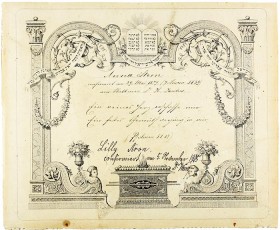
Confirmation certificate for Anna Stern, Aachen 1879 with an added note documenting the confirmation of her daughter Lilly Aron, Berlin 1905; Jewish Museum Berlin, gift of Alexander Summerville, photo: Steffen Engelmann
Among the materials that came to the fore and brought to life many of the names listed in the Haggada were the citizenship paper from 1847 for Samuel Aron, the Jewish confirmation certificate for Anna Stern in Aachen in 1879, the invitation to her wedding with Paul Aron in 1888, the small blackboard that Kurt Aron used at school, and a certificate for Liesel Friedländer for her service as a nurse’s assistant during the First World War.
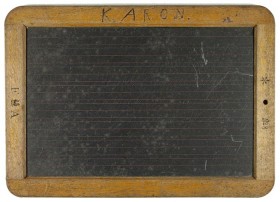
Kurt Aron’s small blackboard, ca. 1903; Jewish Museum Berlin, gift of Alexander Summerville, photo: Steffen Engelmann
A sizeable portion of the papers portray in detail the career of Kurt Aron as a teacher, his dismissal from the public school system in 1933 and ensuing employment as a teacher at various Jewish schools in Berlin, and his intensive but unsuccessful efforts to leave Germany at the end of the 1930s. Documented is also the refusal of the National Socialists to allow Anna Aron to be reunited with her daughter Lilly in the summer of 1942, despite being granted a visa by the Swedish government, and the deportation and murder of her son Kurt in Auschwitz in December of that year, despite his status of being in a so-called privileged marriage. Overall I spent the better part of two full days viewing and perusing the collection, and experienced thereby a wide range of emotions: delight, surprise, bewilderment, and sadness.
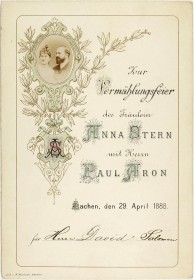
Wedding celebration card of Anna Stern and Paul Aron, Aachen 1888; Jewish Museum Berlin, gift of Alexander Summerville, photo: Steffen Engelmann
Shortly after my visit, Alexander Summerville entrusted the bulk of the documents and photographs pertaining to the Aron and Stern families to the Jewish Museum Berlin, less than a kilometer away from where his great grandfather Paul celebrated Passover with family members. Here they will be inventoried and made available for use in our exhibitions and archival education program, as well as being accessible to external researchers. The collection is a significant and most welcome addition to our holdings, and we wish to thank to Mr. Summerville for this generous donation.
Aubrey Pomerance, who wishes our readers Chag Pessach Sameach!
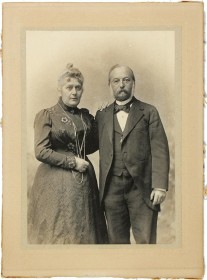
thanks